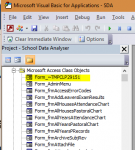isladogs
Access MVP / VIP
- Local time
- Today, 19:38
- Joined
- Jan 14, 2017
- Messages
- 19,349
Hi
After a database object is deleted, Access keeps a copy on memory until the database is closed.
However, if the database crashes for some reason before that has been done, the code for the object remains in the VBE as something like 'Form_~TMPCLP29151 (see screenshot).
The object itself is of course no longer available or listed in the nav pane.
There seems to be no way of deleting the 'phantom' object code from the VBE
Until now, I have got rid of these by periodically creating a new database & copying all items across.
The ~TMPCLP items are of course not transferred.
Just wondering if anyone has a better solution
After a database object is deleted, Access keeps a copy on memory until the database is closed.
However, if the database crashes for some reason before that has been done, the code for the object remains in the VBE as something like 'Form_~TMPCLP29151 (see screenshot).
The object itself is of course no longer available or listed in the nav pane.
There seems to be no way of deleting the 'phantom' object code from the VBE
Until now, I have got rid of these by periodically creating a new database & copying all items across.
The ~TMPCLP items are of course not transferred.
Just wondering if anyone has a better solution

